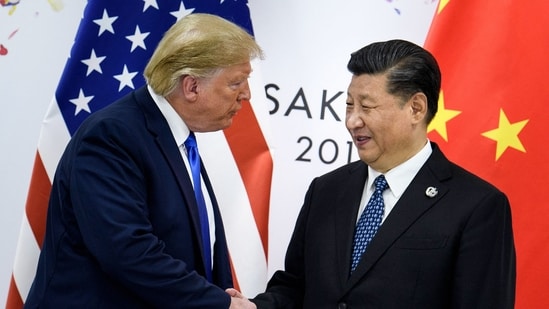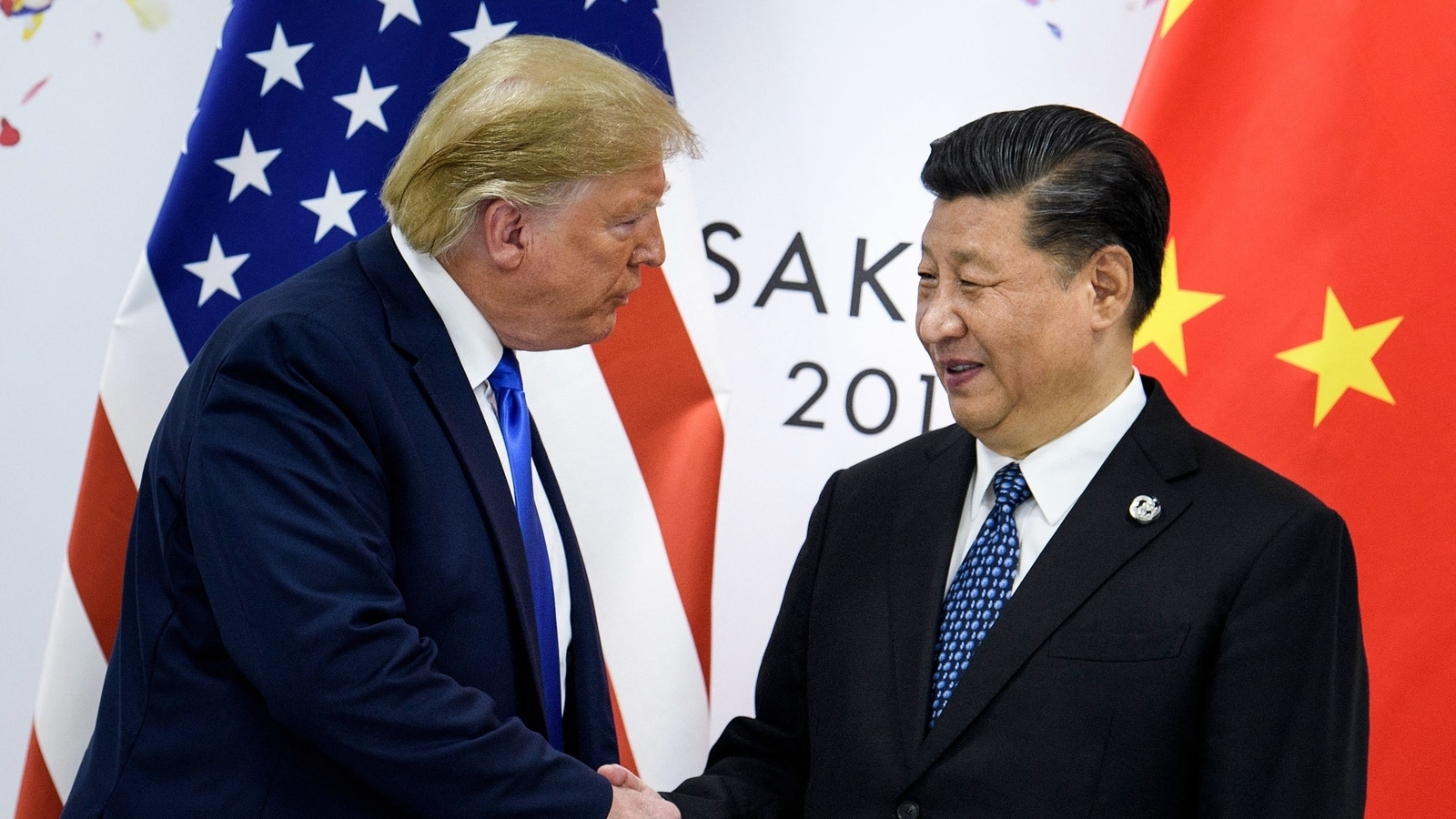ONE OF THE year’s surprises has been how few countries chose to retaliate against Donald Trump’s tariffs with levies of their own. Better, most surmised, to placate the president than risk a costly confrontation. China has been an exception. It matched Mr Trump’s threats tit-for-tat until the two sides struck a last-minute truce in the spring.
 PREMIUM China’s President Xi Jinping (R) shaking hands with US President Donald Trump before a bilateral meeting on the sidelines of the G20 Summit in Osaka(AFP)
PREMIUM China’s President Xi Jinping (R) shaking hands with US President Donald Trump before a bilateral meeting on the sidelines of the G20 Summit in Osaka(AFP)
That peace has now broken. On October 9th China laid out a new set of export controls on rare earths, minerals needed to manufacture most electronics of both the consumer and military sort. The next day, Mr Trump retaliated by announcing an extra 100% tariff on China and export controls on “any and all critical software”.
Stockmarkets slumped as news of the retaliation broke. The benchmark S&P 500 index of large American companies fell by nearly 3%, interrupting a months-long rally fuelled by exuberance over artificial intelligence. But there is still time for the two superpowers to step back from the brink. Mr Trump’s retaliation will not kick in until November 1st, a month before China’s most far-reaching controls take effect. The president acknowledged that the long fuse was in part a negotiating gambit, leaving time for talks. “That’s why I made it November 1st, we’ll see what happens,” he said.
That kind of watchful waiting is proving to be a wise approach to Sino-American relations, which have become hard to manage and difficult to predict. Mr Trump, like many others, was blindsided by China’s escalation. “I never thought it would come to this,” he wrote on his social-media network. The two superpowers had appeared to settle the rare-earths dispute back in June. After talks in London, China promised to unclog the flow of critical minerals, and America withdrew its threatened restrictions on exports like jet engines and software critical to chip design. Hopes were also high that Mr Trump and China’s leader, Xi Jinping, could ease tensions at a planned meeting in South Korea later this month.
China’s hostility “came out of nowhere”, Mr Trump wrote. But that cannot be literally true. It is possible to distinguish three possible motives: preparation, pressure and pique. China’s new regulations are likely to have come out of some mix of the three.
Take preparation first. China’s leaders have long recognised that rare earths are its best weapon in an age of economic warfare. They have therefore been keen to build a regulatory framework that would let them make the most of this weapon, if need be.
The new rules fit into that project. They extend the weapon’s reach far beyond earlier controls. The licence requirements apply, at least on paper, to any product that contains trace amounts of Chinese rare earths, even if that product is sold by a foreign company to a foreign customer. They also apply to products that contain no Chinese rare earths at all, if they were made with Chinese mining, smelting or magnet-making technologies. The rules will be formidably difficult to monitor and enforce. But in principle they claim the kind of “long-arm” jurisdiction that so infuriates China when America resorts to it.
Once the rules are in place, China can decide how quickly and liberally to approve licences—and how forcefully to crack down on rule breakers. China could, in peaceful times, grant licences speedily, minimising disruption to the world’s supply chains. But if trade relations turn sour, it can also dial up the disruption by turning down licences, slow-walking applications and ramping up enforcement. The new rules will, in good times and bad, add to the regulatory “overhead” borne by firms across the tech supply chain. But they are, on this interpretation, intended as a preparatory step not an escalatory one.
They may also be a diplomatic tactic. China is presumably trying to increase pressure on Mr Trump ahead of his planned meeting with Mr Xi at the sidelines of an apec summit at the end of the month. The rare-earth controls are not the only way it is building negotiating leverage. China’s antitrust authorities have recently probed acquisitions by two American chip designers, Nvidia and Qualcomm. China may have been hoping to wield these sticks alongside a variety of carrots, such as promises to buy American soyabeans or invest in American manufacturing plants. On this interpretation, China saw the upcoming meeting as an opportunity to catch Mr Trump in dealmaking mode. Perhaps they thought some combination of threats and rewards could bounce him into cutting existing tariffs on China and further easing American export controls on advanced chips.
The third interpretation is that the regulations are intended as retaliation not escalation. They may be an angry response to the so-called “50%-rule” that America introduced late last month. American officials said that any trade restrictions they place on a foreign company also apply to its subsidiaries, if the parent owns at least 50% of them. The Americans saw the 50%-rule as an innocuous step to close a legal loophole. But China, which is highly sensitive to such measures, may have seen it as a breach of the spirit of the two countries’ recent trade talks.
Whether China’s new export controls were meant as a preparatory step, a pressure tactic or an expression of pique, they were not intended to provoke the kind of angry retaliation Mr Trump has announced. America’s president has threatened to call off his meeting with Mr Xi, which would upset China’s diplomatic calculations. And China’s semiconductor industry would struggle to cope in the near term without American chip-design software.
China’s leaders will also not relish the prospect of even higher tariffs, although they may calculate that three-digit duties will do more harm to America’s economy than its own. Mr Trump’s existing tariffs have not thrown the world’s biggest economy into stagflation. In many cases, American firms have been reluctant to pass the duties on to their customers. But firms will not be able to swallow levies of over 100%. If Mr Trump’s November deadline holds, higher prices will arrive just before the Christmas shopping season gets under way. Santa could be China’s unlikely ally in upcoming negotiations.
Neither superpower, then, wants the trade clash that is now in train. But neither side will find it easy to back down. Although China may be prepared to offer assurances about how its new licence regime will work in practice, it may also be reluctant to repeal a regulation under foreign pressure. For his part, Mr Trump will not want to look weak. And his more sober-minded colleagues, such as Scott Bessent, the treasury secretary, and Jamieson Greer, America’s trade representative, will be feeling aggrieved, having invested so much energy in repeated trade talks with their Chinese counterparts.
After their first meeting in Geneva, Mr Bessent said that earlier escalations in the trade war could have been avoided if the two sides had established regular communication sooner. But the events of the past few days show that even when they talk, the world’s two superpowers remain prone to conflict and miscalculation. Even as they are locked together by mutual dependence, they are divided by mutual suspicion.

